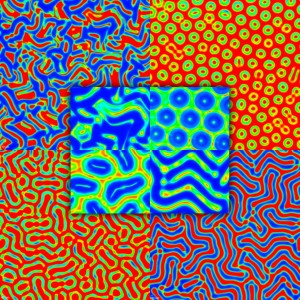Hydrogels undergo volume changes when immersed in water, the degree of which is determined by the network chemical composition and crosslinking. When a hydrogel is attached to a rigid substrate, it swells preferentially perpendicular to the substrate, even though the initial gel was crosslinked homogeneously. This effect arises because the top layer has more freedom to expand. When the osmotic pressure is large enough, the outer surface buckles, resulting in the formation of a surface topography patterns. However, the nonlinear nature of the gel swelling and lack of the control on osmotic pressure make it challenging to control the long-range order and morphology of the final patterns. By introducing crosslinking gradient along the film thickness in poly(2-hydroxylethyl methacrylate) (PHEMA) gels, we are able to fine-tune the network modulus profile, leading to better control of the spontaneous formation of a wide range of surface patterns. Patterns range from highly ordered hexagonal structures to peanut shapes to lamellar and random worm-like structures. We have applied this patterning scheme to create a diverse range of hydrogels for exploration of ideal morphologies for tissue engineering scaffolds. Specifically, it allows us to look at living networks, such as cells, and identify the molecular mechanisms that cells use for mechanosensing.
Jason A. Burdick, and Shu Yang
http://pubs.rsc.org/en/content/articlelanding/2010/sm/b927374c#!divAbstract
Beautiful Science page

